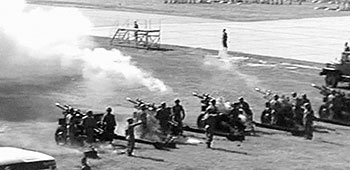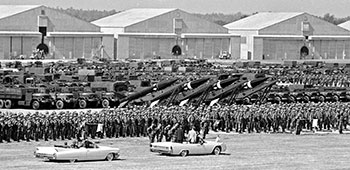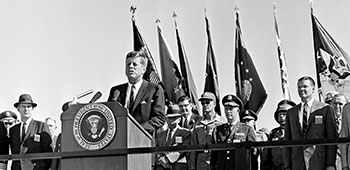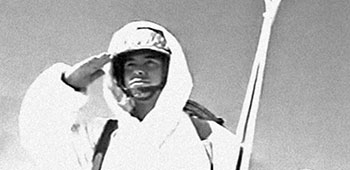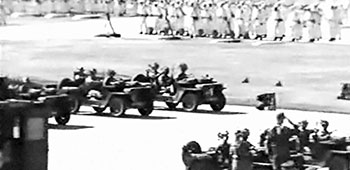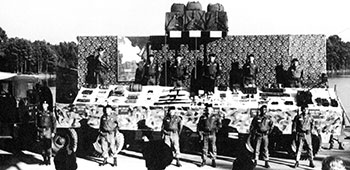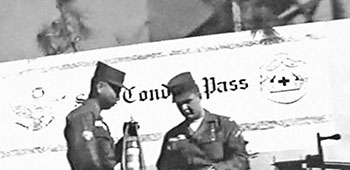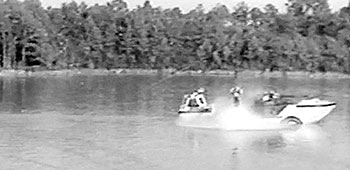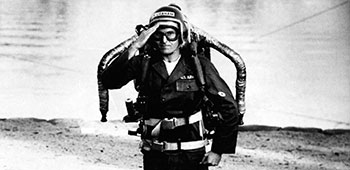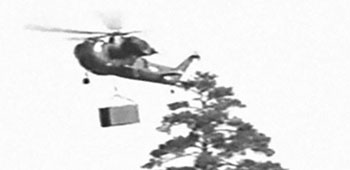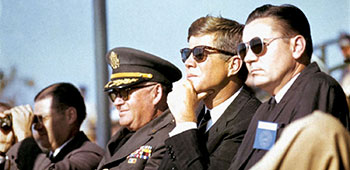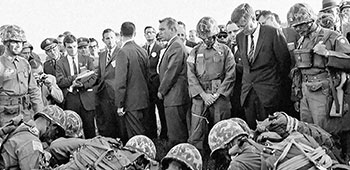SIDEBAR
DOWNLOAD
President John F. Kennedy’s trip to Fort Bragg, NC, on 12 October 1961 is remembered on Smoke Bomb Hill because it has become associated with his approval of the Green Beret for U.S. Army Special Forces (SF) soldiers. During his visit, the 35th President directed that SF wear their berets. While obeying that order was a pleasure, SF unit leaders on Smoke Bomb Hill had to scramble to get everyone in the proper uniform. By following the sequence of events on that day, this essay will dispel some mythology about the president’s visit to Fort Bragg and set it in context with the ongoing Berlin crisis and the Cold War.
President Kennedy began the day by officially mobilizing 23,000 Army Reservists and federalizing twenty-eight Air National Guard flight squadrons for the Berlin crisis.1 On the way to Fort Bragg on 12 October 1961, President Kennedy stopped at Chapel Hill to address 30,000 students, faculty and staff at the University of North Carolina and to receive an Honorary Degree of Laws. Then, he returned to the Raleigh-Durham Airport to board a four-engine turboprop VC-118, an Air Force-VIP converted version of the Douglas DC-6 Skymaster commercial airliner, to come to Pope Air Force Base (AFB).2
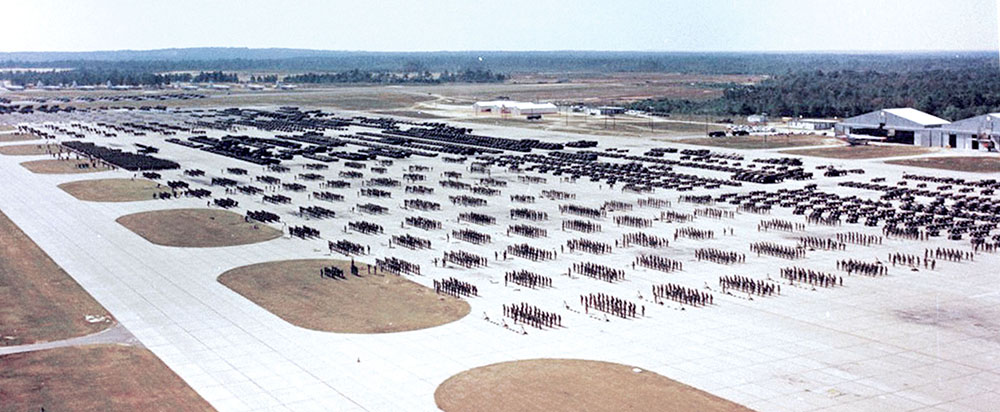
The paratroopers, weaponry, vehicles, helicopters, and equipment of the 82nd and 101st Airborne Divisions were arrayed in ranks along the runways and taxiways of Pope AFB when President Kennedy arrived. Accompanying him on the VC-118 were Secretary of Defense Robert S. McNamara, Secretary of the Army Elvis J. Stahr Jr., the Chairman, Joint Chiefs of Staff (CJCS), General (GEN) Lyman L. Lemnitzer, the Army Chief of Staff (CSA), GEN George H. Decker, and an entourage of Pentagon generals. Airborne color guards held unit colors with Presidential Unit Citation (PUC) streamers next to the reviewing stand.3
After receiving a 21-gun salute from a battery of M-101A1 105mm light howitzers, President Kennedy ‘trooped the line’ with Lieutenant General (LTG) Thomas J.H. ‘Trap’ Trapnell, the Third U.S. Army commander.4 They inspected the paratroops from his Lincoln Continental convertible. The president got out to talk with the soldiers several times before returning to the reviewing stand for remarks.5
After an Air Force fighter bomber flyover and a small firepower demonstration, President Kennedy addressed only the “famous 82nd Airborne Division” and emphasized that their last overseas duty was in Berlin at the end of World War II. Then, he complimented and congratulated the men of the Armed Forces “who have been both soldiers and diplomats at the edge of the Iron and Bamboo Curtains for 16 years.”6
Unheard by almost all Army special warfare soldiers were the president’s words that pertained to them. Conventional warfare was not mutually exclusive from nuclear warfare:
“Just because you give a soldier a pistol does not mean that you are doing away with the artillery. The purpose is to give this nation all the tools — not just some of the tools — that it needs to protect freedom…we are paying more attention to the growing threat — and the growing exercise — of conventional warfare which includes guerrilla warfare, anti-guerrilla warfare, counter-insurgency action, and psychological warfare. I look forward to hearing and seeing the report and demonstrations of the Special Warfare School here at Fort Bragg. In this particular field we are sharing our knowledge and our weapons with our friends from all over the world and, at the same time, we are drawing upon their knowledge and experience and skills to improve our own.”7
Making unconventional warfare an integral part of the conventional forces’ mission had been adroitly accomplished by the CSA, GEN Decker. He had presciently followed President Kennedy’s guidance. In less than four years Army and Marine ground forces were fighting to stop the spread of Communism in South Vietnam.8
LTG Trapnell joined President Kennedy to review the vehicle-mounted paratroopers of the 82nd and 101st Airborne Divisions as they paraded.9 After the review, the Commander-in-Chief and LTG Hamilton L. Howze, the XVIII Airborne Corps commander, got into the two convertibles that led a caravan of cars to McKellar’s Pond. While Brigadier General (BG) William P. Yarborough, commander of the U.S. Army Special Warfare Center, waited at the pond, the presidential caravan drove down roads flanked on both sides by saluting SF soldiers, standing proudly in fatigues and wearing green berets.10
Three months of rehearsals, construction, and site preparation preceded the Army Special Warfare demonstration. McKellar’s Pond was dredged to accommodate amphibious vehicles. A rappel tower, a ‘slide for life’ apparatus, and a dirt road around and behind the reviewing stands were constructed. A full dress rehearsal for the CSA, GEN Decker, and several generals from Washington did not go well six weeks prior. Considerable revamping of the program was directed, and BG Yarborough provided GEN Decker regular status reports.11
Late Thursday morning, 12 October 1961, BG Yarborough welcomed the 35th President, Secretary McNamara, GEN Decker, and the distinguished guests at the reviewing stand. Then, M52 5-Ton Semi-tractor Trucks towing displays mounted on their 12-Ton double-axle Trailers (‘cattle cars’) each stopped momentarily in front of the grandstand, ‘Rose Bowl parade float style.’ This allowed BG Yarborough to reinforce the narrator’s dialogue. First, team members of an Operational Detachment Alpha (ODA) in succession explained their position title, duties, and language qualifications.12 Then, four ‘people’ display trailers covering Special Warfare School curriculum, the elements of counterinsurgency (COIN), the international student program, and a Civic Assistance scene stopped in succession.13 They were followed by a trailer-mounted display of soldiers operating a portable printing press and loading an artillery shell with Psychological Warfare (Psywar) leaflets. Two M-820 5-Ton 6X6 Truck Expansible Print Vans, brought up the rear, signaling the transition to action-oriented activities.14
SF soldiers fought hand-to-hand to demonstrate unarmed combat techniques. Two SF medics controlled the descent of a stretcher-bound ‘wounded’ soldier down the 60-foot rappel tower before two other Green Berets followed in ‘single brake’ rope rappels. Another soldier traversed McKellar’s Pond on the ‘slide for life’ cable, glissading into the water. Explosions, smoke grenades, and firefight simulators across the pond signaled a guerrilla attack as an SF ODA carrying rucksacks camouflaged with pine boughs ‘double-timed’ past the president. The demonstration of SF insertion methods consisted of soldiers paddling two seven-man inflatable rubber boats (RB-7s) while SCUBA team personnel hopped from the stern of a 5-ton amphibious ‘truck,’ a wheeled lighter, amphibious resupply, cargo (LARC) rigged with a plywood silhouette to look like a patrol boat. Two military freefall (MFF) instructors with civilian Para-Commander parachutes splashed into the pond.15 A look to the future followed.
![Diagram of the ‘Rocket Belt’ [Small Rocket Lift Device (SRLD)]](https://arsof-history.org/articles/images/v14n2_jfk_fort_bragg_visit/400/bell_rocket_pack_diagram.jpg)
Research and development potentially for use by SF was explained. A twin-engine CH-37 Mojave medium lift helicopter flew over the pond carrying a sling-loaded CONEX container. A little more exciting was a Bell Aircraft engineer strapped into a 125-pound Rocket Belt, who fired his rockets in a LARC and jetted towards President Kennedy stirring up a great plume of water. The pilot landed, saluted the Commander-in-Chief, and strode away. The demo finale consisted of an L-19 Bird Dog dropping commemorative leaflets upon the assembled caravan of cars.16 Then, forty minutes after the demo started, LTG Howze spirited the president and his entourage off to Sicily Drop Zone (DZ).
An airborne firepower demonstration awaited. It began with a pair of Air Force F-104 Starfighters screaming overhead to drop bombs and napalm. After the aerial bombardment, a 600-man airborne infantry battalion from the 101st Airborne Division filled the sky in a mass tactical parachute assault from C-130 Hercules transports. Vehicles and artillery followed the personnel drop. After talking with some 101st Airborne soldiers, President Kennedy and his group headed back to Pope AFB to return home to Washington, DC.17
Three months’ work produced a highly supervised and well-rehearsed ‘dog and pony’ military capabilities show for President Kennedy on 12 October 1961. BG Yarborough had addressed the Commander-in-Chief’s challenge to incorporate Special Warfare into the Army mission sets and make COIN simple. This visit placed SF in the vanguard of America’s fight against ‘Wars of National Liberation’ threatening developing nations worldwide. Though the ‘lion’s share’ of the Commander-in-Chief’s time (4 ½ hours) had been devoted to the national strategic ready force (XVIII Airborne Corps), great lasting impressions of SF were made.18 The visit to Fort Bragg in 1961 by the charismatic JFK will be long remembered by Army Special Operations veterans and the Fort Bragg/Fayetteville communities.

